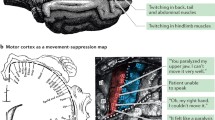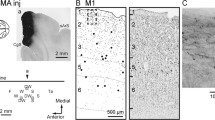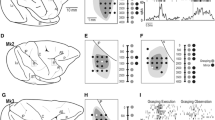Abstract
The concept of the primate motor cortex based on the cytoarchitectonic subdivision into areas 4 and 6 according to Brodmann or the functional subdivision into primary motor, supplementary motor, and lateral premotor cortex has changed in recent years. Instead, this cortical region is now regarded as a complex mosaic of different areas. This review article gives an overview of the structure and function of the isocortical part of the motor cortex in the macaque and human brain. In the macaque monkey, the primary motor cortex (Brodmann’s area 4 or area F1) with its giant pyramidal or Betz cells lies immediately anterior to the central sulcus. The non-primary motor cortex (Brodmann’s area 6) lies further rostrally and can be subdivided into three groups of areas: the supplementary motor areas ”SMA proper” (area F3) and ”pre-SMA” (area F6) on the mesial cortical surface, the dorsolateral premotor cortex (areas F2 and F7) on the dorsolateral convexity, and the ventrolateral premotor cortex (areas F4 and F5) on the ventrolateral convexity. The primary motor cortex is mainly involved in controlling kinematic and dynamic parameters of voluntary movements, whereas non-primary motor areas are more related to preparing voluntary movements in response to a variety of internal or external cues. Since a structural map of the human isocortical motor system as detailed as in the macaque is not yet available, homologies between the two species have not been firmly established. There is increasing evidence, however, that a similar organizational principle (i.e., primary motor cortex, supplementary motor areas, dorso- and ventrolateral premotor cortex) also exists in humans. Imaging studies have revealed that functional gradients can be discerned within the human non-primary motor cortex. More rostral cortical regions are active when a motor task is nonroutine, whereas more routine motor actions engage more caudal areas.
Similar content being viewed by others
Author information
Authors and Affiliations
Additional information
Accepted: 3 July 2000
Rights and permissions
About this article
Cite this article
Geyer, S., Matelli, M., Luppino, G. et al. Functional neuroanatomy of the primate isocortical motor system. Anat Embryol 202, 443–474 (2000). https://doi.org/10.1007/s004290000127
Issue Date:
DOI: https://doi.org/10.1007/s004290000127




